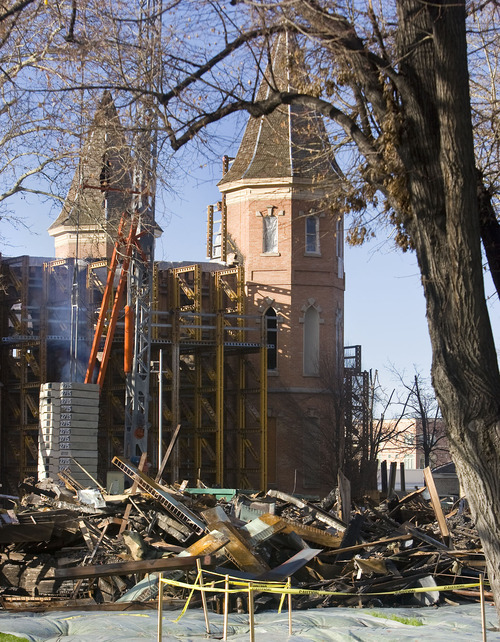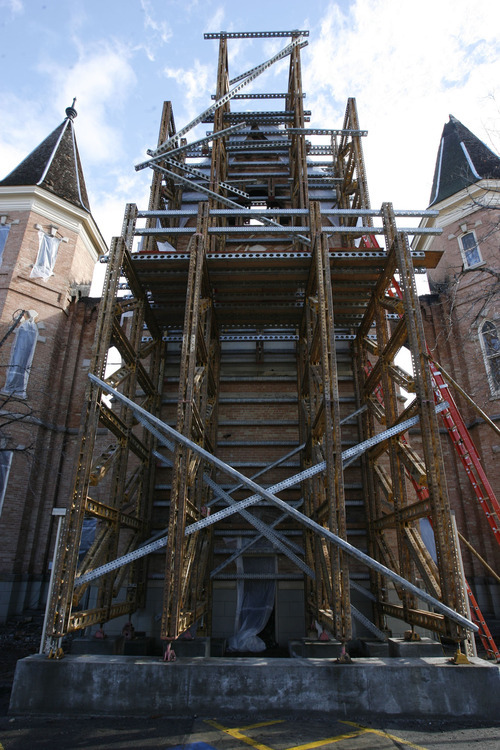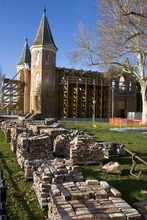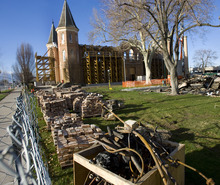This is an archived article that was published on sltrib.com in 2011, and information in the article may be outdated. It is provided only for personal research purposes and may not be reprinted.
Provo • A series of errors doomed the historic Provo LDS Tabernacle to fiery destruction on Dec. 17, investigators concluded in a report released Thursday.
After a three-month investigation, Provo Fire & Rescue Fire Marshal Lynn Schofield determined that the fire started when a technician left a lighting fixture too close to a wooden speaker box in the tabernacle's attic the night of Dec. 16. The light fixture, which was still connected to power, heated the wood during a dress rehearsal for Lex de Acevedo's "Gloria" to the point that it ignited.
But Schofield said the light's placement by Jeremy Ostler, owner of Trax Lighting and AV of Clearfield, wasn't the only human error that contributed to the fire, which he said was unintentional.
"It was a series of mistakes, and one compounded the next one," Schofield said. The result was a perfect storm that destroyed the 103-year-old building.
One of the first mistakes was that the building's owner, The Church of Jesus Christ of Latter-day Saints, failed to notify the city that the tabernacle's alarm system failed a test in early December because of sensitivity problems.
Among the other missteps:
• Attic smoke detectors were placed in such a way that they wouldn't go off until a fire had progressed significantly — and there were no automatic sprinklers.
• People who smelled what they thought was smoke that night, or who saw what looked like fog or smoke around the building, didn't alert the fire officials.
• The building's alarm system wasn't monitored off-site. But even when the alarm went off, building managers who had developed "apathy" because of false alarms told the on-duty security guard to disable it.
The events leading up to the blaze began on Dec. 15, when Ostler, who was hired by Brigham Young University Broadcasting to assist with the taping of "Gloria," decided the existing lights were insufficient. He went to the attic and removed two 300-watt light fixtures in order to hang a truss with additional lights.
Ostler initially told investigators the lights weren't powered, but he later said they were attached to a tether with wire nuts.
A man who answered the phone at Trax Lighting and AV on Thursday said Ostler didn't want to comment.
Schofield said the city wasn't informed about the change in the lighting plan and didn't inspect it. He said the city would review its inspection policies to see if that issue needs to be addressed. Had inspectors looked at the setup, they might have seen that the ceiling lights were still powered.
During the rehearsal, the lights were turned on, including at least one of the lights that had been removed, and remained on for the duration.
Schofield said tests using wood from the tabernacle and a similar light fixture indicated the several-hour period was enough time to char the wood and start a fire.
The first witness account of any fire was at 1 a.m., when a courier driving through Provo saw what looked like fog around the tabernacle. While he thought it unusual because he hadn't seen fog elsewhere, he didn't report it.
The alarm didn't go off until 1:10 a.m., when off-duty Provo police Officer Austin Williams, who was hired to watch BYU's trailers and keep the heat on in the building, went inside to investigate. The report said Williams walked through the building and the balcony, and while he heard crackling and popping, he assumed it was the building "settling," the report said.
Williams told investigators he believed it was an intruder alarm, but he didn't know how to get to the attic. The 25-year-old alarm panel relied on lights to indicate where an alarm was going off, but it didn't give details as to what kind of alarm it was.
Had Williams called the Fire Department at that time, Schofield said firefighters may have been able to save some of the tabernacle.
"We would have lost the west half of the building," Schofield said.
He said the alarm system met the codes for 1985, but it wasn't up to date.
Williams contacted Tyler Weston, a BYU producer who, in turn, contacted the building's supervisors, who told Williams to silence the alarm. Williams said his initial efforts failed, as it went off repeatedly, but the alarm was eventually turned off.
It was 2:43 a.m. when a Nu Skin Enterprises guard told Williams there appeared to be smoke coming off the tabernacle's roof. Williams went in and saw a flaming hole in the ceiling and smoke in the main hall.
Schofield said, at that point, the fire had consumed nearly all the oxygen in the 54,000-square-foot attic, and as it burned through the ceiling, the rush of oxygen gave it new life. Burning debris set fire to the production set, allowing the fire to spread in the tabernacle's choir loft. The report estimated the destruction of the building and its contents at $15 million.
Among items lost in the blaze were a $136,000 Fazioli piano that BYU had rented for the performance. Rick Baldasin, the piano's owner, said his claim has been resolved, but he declined to say whose insurance paid for it.
Schofield said Williams' description of the burning hole and Ostler's account of his lighting installation gave investigators the clues they needed to home in on the cause of the fire.
He credited the church with helping advance the investigation by hiring a construction crew to assist in removing debris and stabilizing the building's brick walls.
The ruins have been turned over to the church. LDS Church spokesman Scott Trotter said the church is still determining whether to rebuild the tabernacle.
dmeyers@sltrib.com twitter.com/donaldwmeyers —
Online • The full report
O Read the full report on the Provo Tabernacle • goo.gl/GT68D.
An executive summary is available at • goo.gl/lXmTd.













